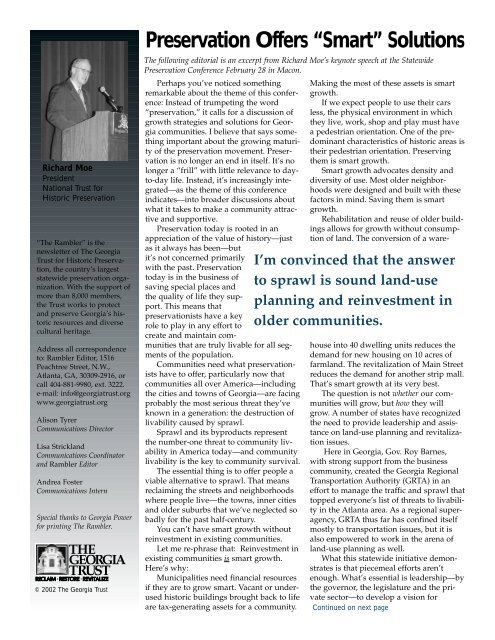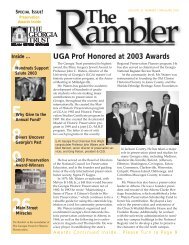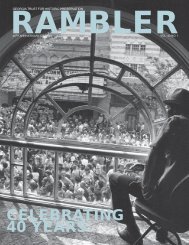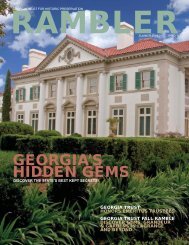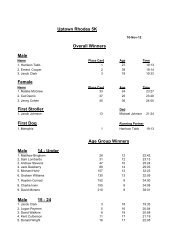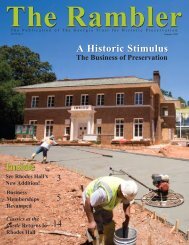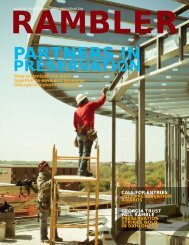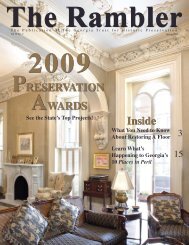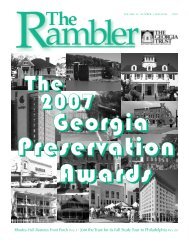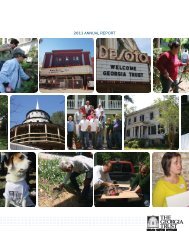May/June 2002 - The Georgia Trust for Historic Preservation
May/June 2002 - The Georgia Trust for Historic Preservation
May/June 2002 - The Georgia Trust for Historic Preservation
Create successful ePaper yourself
Turn your PDF publications into a flip-book with our unique Google optimized e-Paper software.
Richard MoePresidentNational <strong>Trust</strong> <strong>for</strong><strong>Historic</strong> <strong>Preservation</strong>“<strong>The</strong> Rambler” is thenewsletter of <strong>The</strong> <strong>Georgia</strong><strong>Trust</strong> <strong>for</strong> <strong>Historic</strong> <strong>Preservation</strong>,the country’s largeststatewide preservation organization.With the support ofmore than 8,000 members,the <strong>Trust</strong> works to protectand preserve <strong>Georgia</strong>’s historicresources and diversecultural heritage.Address all correspondenceto: Rambler Editor, 1516Peachtree Street, N.W.,Atlanta, GA, 30309-2916, orcall 404-881-9980, ext. 3222.e-mail: info@georgiatrust.orgwww.georgiatrust.orgAlison TyrerCommunications DirectorLisa StricklandCommunications Coordinatorand Rambler EditorAndrea FosterCommunications InternSpecial thanks to <strong>Georgia</strong> Power<strong>for</strong> printing <strong>The</strong> Rambler.© <strong>2002</strong> <strong>The</strong> <strong>Georgia</strong> <strong>Trust</strong><strong>Preservation</strong> Offers “Smart” Solutions<strong>The</strong> following editorial is an excerpt from Richard Moe’s keynote speech at the Statewide<strong>Preservation</strong> Conference February 28 in Macon.Perhaps you’ve noticed somethingremarkable about the theme of this conference:Instead of trumpeting the word“preservation,” it calls <strong>for</strong> a discussion ofgrowth strategies and solutions <strong>for</strong> <strong>Georgia</strong>communities. I believe that says somethingimportant about the growing maturityof the preservation movement. <strong>Preservation</strong>is no longer an end in itself. It’s nolonger a “frill” with little relevance to dayto-daylife. Instead, it’s increasingly integrated—asthe theme of this conferenceindicates—into broader discussions aboutwhat it takes to make a community attractiveand supportive.<strong>Preservation</strong> today is rooted in anappreciation of the value of history—justas it always has been—butit’s not concerned primarilywith the past. <strong>Preservation</strong>today is in the business ofsaving special places andthe quality of life they support.This means thatpreservationists have a keyrole to play in any ef<strong>for</strong>t tocreate and maintain communitiesthat are truly livable <strong>for</strong> all segmentsof the population.Communities need what preservationistshave to offer, particularly now thatcommunities all over America—includingthe cities and towns of <strong>Georgia</strong>—are facingprobably the most serious threat they’veknown in a generation: the destruction oflivability caused by sprawl.Sprawl and its byproducts representthe number-one threat to community livabilityin America today—and communitylivability is the key to community survival.<strong>The</strong> essential thing is to offer people aviable alternative to sprawl. That meansreclaiming the streets and neighborhoodswhere people live—the towns, inner citiesand older suburbs that we’ve neglected sobadly <strong>for</strong> the past half-century.You can’t have smart growth withoutreinvestment in existing communities.Let me re-phrase that: Reinvestment inexisting communities is smart growth.Here’s why:Municipalities need financial resourcesif they are to grow smart. Vacant or underusedhistoric buildings brought back to lifeare tax-generating assets <strong>for</strong> a community.I’m convinced that the answerto sprawl is sound land-useplanning and reinvestment inolder communities.Making the most of these assets is smartgrowth.If we expect people to use their carsless, the physical environment in whichthey live, work, shop and play must havea pedestrian orientation. One of the predominantcharacteristics of historic areas istheir pedestrian orientation. Preservingthem is smart growth.Smart growth advocates density anddiversity of use. Most older neighborhoodswere designed and built with thesefactors in mind. Saving them is smartgrowth.Rehabilitation and reuse of older buildingsallows <strong>for</strong> growth without consumptionof land. <strong>The</strong> conversion of a warehouseinto 40 dwelling units reduces thedemand <strong>for</strong> new housing on 10 acres offarmland. <strong>The</strong> revitalization of Main Streetreduces the demand <strong>for</strong> another strip mall.That’s smart growth at its very best.<strong>The</strong> question is not whether our communitieswill grow, but how they willgrow. A number of states have recognizedthe need to provide leadership and assistanceon land-use planning and revitalizationissues.Here in <strong>Georgia</strong>, Gov. Roy Barnes,with strong support from the businesscommunity, created the <strong>Georgia</strong> RegionalTransportation Authority (GRTA) in anef<strong>for</strong>t to manage the traffic and sprawl thattopped everyone’s list of threats to livabilityin the Atlanta area. As a regional superagency,GRTA thus far has confined itselfmostly to transportation issues, but it isalso empowered to work in the arena ofland-use planning as well.What this statewide initiative demonstratesis that piecemeal ef<strong>for</strong>ts aren’tenough. What’s essential is leadership—bythe governor, the legislature and the privatesector—to develop a vision <strong>for</strong>Continued on next page


